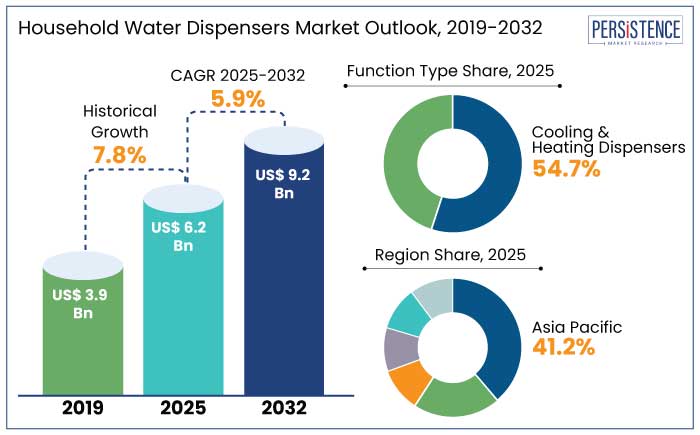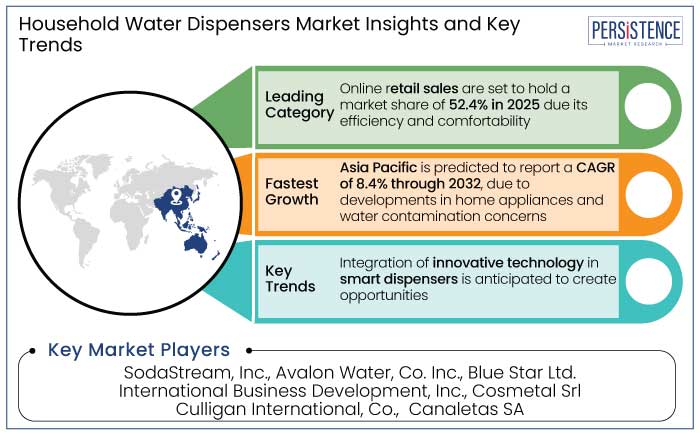ID: PMRREP33988| 186 Pages | 15 Jan 2025 | Format: PDF, Excel, PPT* | Consumer Goods

The global household water dispensers market is estimated to reach a size of US$ 6.2 Bn in 2025. It is predicted to rise at a CAGR of 5.9% through the assessment period to attain a value of US$ 9.2 Bn by 2032.
Demand for water dispensing equipment is surging because of its mobility, minimal maintenance needs, and increased emphasis on health and wellbeing. The need for safe drinking water solutions has skyrocketed due to the COVID-19 pandemic, which has accelerated the use of contemporary dispensers. For example, infrared sensor-based models, like the Quench Q8 introduced in October 2023, are gaining traction for their touchless operation and convenience.
Innovations such as built-in purification systems and smart features are reshaping the market. For instance, in November 2023, Elkay launched a line of smart water dispensers featuring real-time water quality monitoring and app connectivity. E-commerce platforms like Amazon and Alibaba are boosting sales through targeted campaigns, while developments in water technology and sustainable solutions continue to drive global consumer interest and adoption.

Key Highlights of the Market
|
Market Attributes |
Key Insights |
|
Household Water Dispensers Market Size (2025E) |
US$ 6.2 Bn |
|
Projected Market Value (2032F) |
US$ 9.2 Bn |
|
Global Market Growth Rate (CAGR 2025 to 2032) |
5.9% |
|
Historical Market Growth Rate (CAGR 2019 to 2023) |
7.8% |
In 2025, North America is set to attain a market share of 34.8% of the global market, driven by increasing demand for novel home appliances in the U.S. and Canada. The region’s market growth is predicted to surge at a CAGR of 7.2% from 2025 to 2032, fueled by rising consumer preferences for smart, energy-efficient solutions. For instance,
North America's energy-efficient appliances market is bolstered by government incentives like the Energy Star rebate program, highlighting its significant role in the global market.
Asia Pacific is projected to dominate globally, accounting for 41.2% of the market share in 2025, with a forecast CAGR of 8.4% from 2025 to 2032. Demand for clean drinking water is surging due to increasing consumer demand, technological innovations, and concerns about water contamination in Asia Pacific. For example,
Governments in China and Indonesia are investing in large-scale water purification projects to combat public health issues, preparing for sustained market growth in Asia Pacific.
The cooling and heating dispensers segment is set to dominate the household water dispensers industry, accounting for 54.7% of the market share in 2025, driven by increasing consumer demand for all-in-one solutions. Dispensers cater to various consumer preferences, including climates requiring instant cold water and households needing hot water for beverages and cooking. For example,
Given its emphasis on comfort, convenience, and technological innovation, the market is anticipated to rise quickly.
Online retail is projected to dominate the household water dispensers market, holding a projected 52.4% share in 2025. It will likely be driven by high affordability, accessibility, and diverse product choices. The convenience of purchasing from home has influenced consumer behavior, with platforms like Amazon and Alibaba leading the market. For instance,
Online retail is gaining momentum, with direct sales rising due to personalized approaches. For example,
Growing awareness of safe drinking water and concerns regarding water pollution are driving demand for household water dispensers. For instance,
Demand for bottle-less dispensers is surging as organizations aim to reduce single-use plastic waste. For example,
Urbanization and workplace wellness initiatives drive adoption. Companies like Elkay extended their touchless hydration station lineup in October 2023, promoting hygiene and convenience in office environments. For instance,
Smart water dispensers with IoT capabilities and sustainable designs are shaping market trends, meeting the diverse demands of urban and commercial consumers.

The global household water dispensers market recorded a CAGR of 7.8% in the historical period from 2019 to 2023. Rising disposable income, urbanization, and increasing consumer awareness of the health advantages of clean water propelled the worldwide household water dispenser industry’s notable growth between 2019 and 2023. For example,
Rising need for smart and creative water dispenser solutions is predicted to fuel the market's growth. Demand for household water dispensers is estimated to record a considerable CAGR of 5.9% during the forecast period between 2025 and 2032.
Availability of Energy-efficient Water Dispensers Enhances Consumer Base
Demand for energy-efficient water dispensers is reshaping the industry, with manufacturers prioritizing innovation to reduce energy consumption. For example,
Governments are promoting energy-efficient appliances, such as water dispensers, as sustainability becomes a top priority, with the U.S. Department of Energy raising its Energy Star program in 2023.
Rising Adoption in Offices and Schools to Propel Demand Worldwide
Demand for water dispensers is on the rise due to growing need for clean, safe drinking water in various settings like offices, educational institutions, and healthcare facilities. This demand is primarily driven by stringent health regulations and limited potable water supplies in commercial locations, resulting in a remarkable growth in the household water dispensers market.
In a variety of commercial settings, such as public transit hubs, retail malls, entertainment venues, corporate offices, and schools, these dispensers are indispensable. In public spaces, educational settings, and workplaces, these facilitate convenient access to clean water, so fostering health and wellbeing. By meeting the demands of both organizations and consumers, these dispensers emphasize how crucial being hydrated is in the fast-paced world of today.
Utilization of Subpar Materials in Production May Hamper the Industry
The environmental impact of plastic bottles and their improper disposal has caused a shift in the global demand for household water dispensers. It is further leading to a shift toward sustainable alternatives like glass or metal and reusable materials. Leading industry players must concentrate on creating sustainable packaging and educating consumers about their products.
As consumers' options have increased due to competition from alternative water sources and delivery methods, manufacturers are finding it more difficult to differentiate their products. In order to stay competitive, companies must prioritize sustainability, implement strategic marketing initiatives, and differentiate their products by emphasizing convenience, unique filtration technologies, and reducing the percentage of single-use plastic.
Integration of Innovative Technology in Modern Dispensers Presents Prospects
Modern water dispensers are integrating UV sterilization and novel filtration technologies to enhance water safety and quality, meeting consumer demand for germ-free, purified drinking water. For instance,
Following the pandemic, rising health consciousness and more stringent water safety standards have made smart technology like UV and sophisticated filtration-equipped dispensers indispensable for homes and businesses.
Automation in Water Quality Testing and Monitoring Services Offers Opportunities
Water quality testing and monitoring services are gaining popularity as a supplement to water dispenser sales, enhancing customer trust and addressing health concerns and technological developments. For example,
Household water dispensers are a crucial aspect of modern living, and market leaders in this sector are strategically positioning themselves to gain the highest possible market share. They invest heavily in research and development, introducing technologically unique water dispensers that cater to changing consumer preferences.
Smart dispensers incorporate intelligent technologies like IoT connectivity and AI-powered functionalities, enhancing convenience, control, and real-time monitoring. Strategic partnerships with suppliers, distributors, and retail channels are crucial for a resilient supply chain.
E-commerce platforms are also significant, as the transition to online retail is increasing. Market leaders prioritize brand recognition and customer involvement, offering post-purchase assistance, warranty bundles, and customized guidance. This comprehensive strategy helps maintain and increase their market dominance in the household water dispensers market.
Recent Industry Developments
The market size is set to reach US$ 9.2 Bn by 2032.
Gravity-fed water dispensers, typically made of stainless steel or plastic, store water in a tank and dispense through a tap, making these suitable for areas without electricity.
In 2025, North America is set to attain a market share of 34.8%.
In 2025, the market is estimated to be valued at US$ 6.2 Bn.
SodaStream, Inc., Avalon Water, Co. Inc., Blue Star Ltd., International Business Development, Inc., and Cosmetal Srl are a few key players.
|
Attributes |
Details |
|
Forecast Period |
2025 to 2032 |
|
Historical Data Available for |
2019 to 2023 |
|
Market Analysis |
US$ Billion for Value |
|
Key Regions Covered |
|
|
Key Market Segments Covered |
|
|
Key Companies Profiled in the Report |
|
|
Report Coverage |
|
|
Customization and Pricing |
Available upon request |
By Function Type
By Distribution Channel
By Region
Delivery Timelines
For more information on this report and its delivery timelines please get in touch with our sales team.
About Author